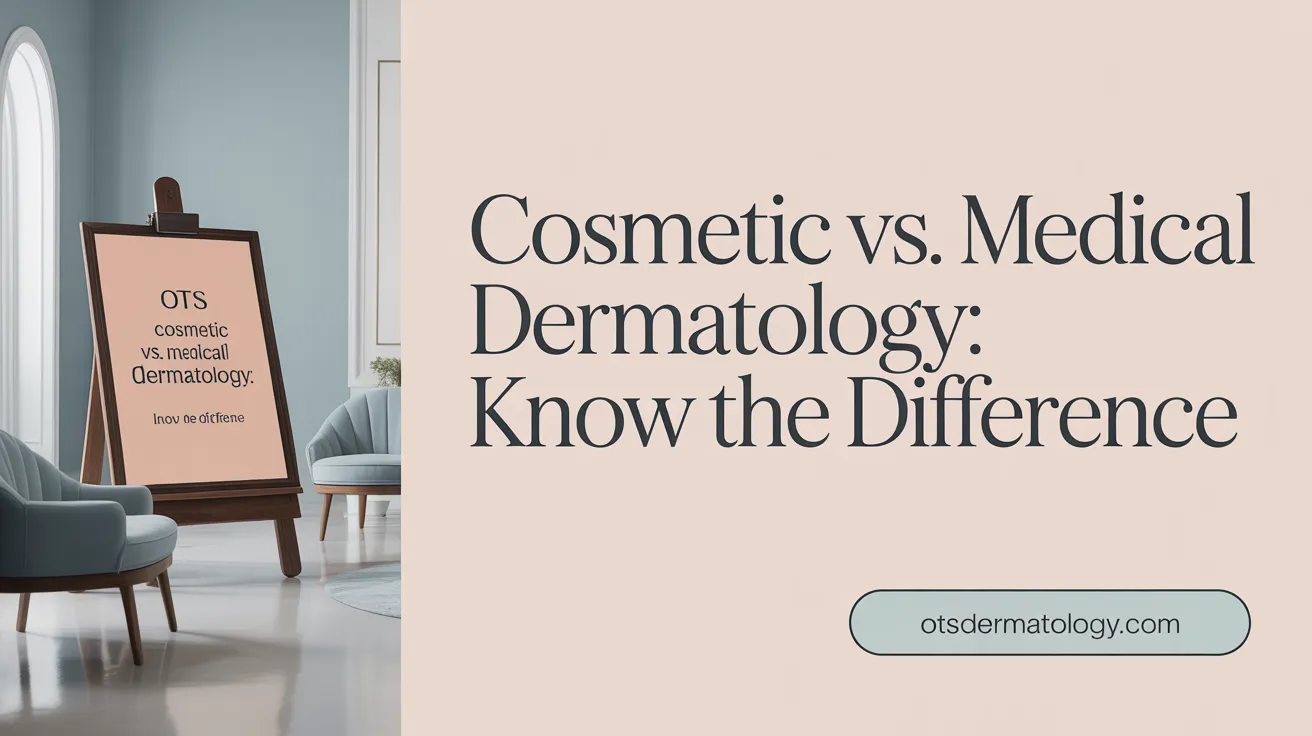Introduction to Cosmetic Dermatology
Cosmetic dermatology has evolved into a dynamic field dedicated to improving skin appearance and boosting confidence through specialized treatments. From injectables like Botox to regenerative therapies such as PRP, this branch intersects science and aesthetics to offer youthful, rejuvenated skin without invasive surgery. This article explores the essentials of cosmetic dermatology, unpacking its scope, popular treatments, mechanisms, safety, and practical tips for maintaining skin health alongside these procedures.
Understanding Cosmetic Dermatology: Scope and Distinctions

What is cosmetic dermatology and what does it include?
Cosmetic dermatology is a specialized branch of dermatology focused on enhancing the skin's appearance through a variety of non-surgical and minimally invasive procedures. It aims to improve aesthetic concerns such as wrinkles, volume loss, skin texture, and body shape. Typical treatments include Botox injections, dermal fillers, laser skin resurfacing, chemical peels, microneedling often combined with Platelet Rich Plasma (PRP), and non-invasive body contouring methods like CoolSculpting®. Many clinics and medspas offer these services, often led by specially trained dermatologist practitioners.
Procedures target issues like fine lines, scars, pigmentation, and stubborn fat, helping patients achieve a more youthful and smooth look. Additional treatments may include skin tightening, skin tag removal, and photorejuvenation, all designed to restore confidence through safe, effective, and personalized care.
What is the difference between cosmetic dermatology and medical dermatology?
While both fields are rooted in dermatological expertise, their primary goals differ. Medical dermatology deals with diagnosing and treating skin conditions and diseases that impact health, including skin cancers, eczema, psoriasis, and infections. These conditions often require medications, surgical interventions, or other medical procedures.
In contrast, cosmetic dermatology specializes in treatments that are elective and primarily aimed at improving appearance. These procedures include Botox to reduce wrinkles, dermal fillers to restore volume, laser treatments for skin tone correction, chemical peels, and photorejuvenation.
Understanding this distinction is important for patients seeking care, as medical dermatology addresses health issues, whereas cosmetic dermatology focuses on aesthetic enhancement. Medical dermatologists are trained to treat skin diseases, while aesthetic procedures are typically performed by dermatologists with additional training in cosmetic techniques.
| Aspect | Medical Dermatology | Cosmetic Dermatology | Key Focus | Health condition management | Aesthetic presentation improvement |
|---|---|---|---|---|---|
| Goals | Diagnose and treat skin disorders | Enhance appearance and youthfulness | Focus | Skin health and disease | Skin appearance and confidence |
| Procedures | Medications, surgeries, biopsies | Botox, fillers, lasers, peels | Nature of treatments | Medical necessity | Elective aesthetic enhancement |
This clear separation helps in selecting the right treatment based on whether health concerns or aesthetic goals are the priority, providing tailored skincare solutions.
Popular Cosmetic Dermatology Treatments: What’s Trending?

What are the most popular cosmetic dermatology treatments?
The most sought-after treatments in cosmetic dermatology include Botox injections and dermal fillers such as Juvederm and Restylane. These procedures are highly effective in reducing facial wrinkles and restoring lost volume, helping individuals achieve a smoother, more youthful appearance.
Laser therapies also play a significant role in aesthetic improvements. Techniques like laser resurfacing using devices such as Fraxel, Pixel CO2, and MOXI are widely used to enhance skin texture, tone, and address pigmentation issues or sun damage.
Microneedling is another trending treatment that stimulates collagen production, often combined with plate-rich plasma (PRP) or radiofrequency to maximize skin rejuvenation. It effectively reduces scars and fine lines.
Chemical peels, which range from superficial to deep, are favored for improving hyperpigmentation, acne scars, and skin dullness. They help refresh the skin surface and restore radiance.
Lastly, non-invasive treatments like BroadBand Light (BBL) therapy and HydraFacial are popular for brightening skin, deep cleansing, and providing an overall glow. These procedures are quickly performed, with minimal downtime, making them favorites among those seeking effective results with convenience.
What different aesthetic procedures are available and what results can be expected from them?
Aesthetic procedures vary from non-invasive to minimally invasive options tailored to specific concerns such as aging, scars, or body shape.
Botox and dermal fillers are primarily used to diminish wrinkles and enhance facial contours, delivering quick results that last several months.
Chemical peels and laser treatments improve skin quality by reducing pigmentation, acne scars, and roughness, often showing noticeable difference after a few sessions.
Microneedling and PRP therapy are excellent for stimulating collagen and hair growth, with results developing over time through tissue regeneration.
Body contouring options like CoolSculpting selectively target stubborn fat deposits, sculpting the body’s shape with minimal discomfort.
Results from these procedures generally include visibly smoother skin, improved tone and texture, and a more youthful, refreshed appearance. Most treatments are safe, with quick recovery times, and can be customized highly effectively to meet individual aesthetic goals.
Many patients experience immediate improvements, while some procedures require multiple sessions for optimal outcomes, making personalized treatment planning essential.
The Science Behind Botox and PRP: Mechanisms and Safety

How do Botox and PRP therapy work, and are they safe?
Botox, also known by its medical name onabotulinum toxin, functions by blocking nerve signals to specific facial muscles. When injected into targeted areas like the forehead or crow’s feet, it causes temporary muscle relaxation. This relaxation smooths out existing wrinkles and prevents new lines from forming, resulting in a fresher, more youthful appearance. The effects typically last three to six months, requiring repeat treatments to maintain results.
PRP, or Platelet-Rich Plasma therapy, involves a different approach. It starts with drawing a small amount of the patient’s blood, which is then spun in a centrifuge to separate and concentrate platelets rich in growth factors. These biologically active proteins play a crucial role in healing, tissue repair, and collagen production. The processed PRP is either injected into the skin or applied through microneedling, stimulating the body's natural regenerative processes.
Regarding safety, both treatments are considered safe when administered by trained and licensed professionals. PRP's safety profile is particularly high because it uses the patient’s own blood, eliminating risks of allergic reactions or disease transmission. Minor side effects such as redness, swelling, or soreness are common but temporary. Botox’s safety has been well established through extensive clinical use; when properly injected, it does not affect normal muscle movement and poses minimal risk.
In summary, Botox provides quick, effective wrinkle reduction via muscle relaxation with a high safety record when used correctly. PRP supports natural healing and skin rejuvenation, with a safety profile that is highly favorable due to its autologous nature. Both treatments, however, should only be performed by experienced professionals to ensure safety and optimal outcomes.
Unpacking Botox and PRP Benefits: What to Expect

What are the benefits of Botox and PRP therapy?
Botox is renowned for its ability to provide quick results by relaxing specific facial muscles that cause wrinkles. This action smooths out lines like frown lines, forehead wrinkles, and crow’s feet, making the skin appear more youthful. The effects usually last about three to six months, requiring repeat treatments to maintain results.
PRP therapy, on the other hand, promotes skin health from within. It utilizes the patient’s own concentrated platelets and growth factors, which stimulate collagen and elastin production. This process improves skin texture, firmness, and tone gradually over approximately 90 days. Advanced signs of aging, such as fine lines, wrinkles, scars, and pigmentation, can be significantly reduced with consistent treatments.
When used together, these therapies complement each other effectively. Botox offers an immediate smoothing effect, ideal for quick visible improvements. Meanwhile, PRP boosts the skin’s natural regenerative abilities, providing longer-lasting results and enhancing overall skin quality. Both treatments are minimally invasive, safe, and involve little to no downtime, making them popular options for individuals seeking to rejuvenate their appearance naturally.
PRP’s versatility extends beyond facial rejuvenation; it can also aid in hair restoration and scar treatment, supporting tissue healing and regeneration. Botox’s primary role is muscle relaxation, which prevents wrinkle formation caused by repetitive facial movements. Combined, they provide a balanced approach to comprehensive cosmetic improvements, offering both instant and sustained aesthetic benefits.
Baby Botox and Maintaining Healthy Skin: Tips and Candidates

What is Baby Botox, how is the procedure performed, and who are the ideal candidates?
Baby Botox, also known as MicroTox, is a subtle injectable treatment that uses smaller doses of botulinum toxin to gently soften fine lines and wrinkles. Unlike traditional Botox, which aims for more pronounced muscle relaxation, Baby Botox targets areas around the eyes, forehead, and lips for a natural, refreshed look.
The procedure is quick, usually taking between 15 to 30 minutes, and is performed by experienced practitioners who precisely inject the smaller amounts of toxin into targeted muscles. Results typically start to appear within one to two weeks and can last approximately two to three months.
Ideal candidates for Baby Botox are generally younger adults looking to prevent the formation of wrinkles or those who desire a more natural appearance without drastic changes. It’s particularly suitable for individuals with mild to moderate dynamic muscle activity, such as fine lines or crow’s feet. Candidates new to Botox or those seeking subtle enhancement often prefer this approach. As with any cosmetic treatment, a consultation with a qualified healthcare professional is important to ensure safety, especially if there are allergies or pre-existing conditions.
How can someone maintain good skin health alongside cosmetic dermatological treatments?
Maintaining great skin health is crucial when undergoing cosmetic procedures like Baby Botox. A consistent skincare routine forms the foundation, including gentle cleansing and daily application of broad-spectrum sunscreen to protect against UV damage.
Using targeted products such as moisturizers with repair ingredients and antioxidants like vitamin C can boost the skin’s resilience and promote healing. It’s best to avoid harsh skincare ingredients, over-exfoliation, and hot water, which can strip the skin and cause irritation.
Lifestyle choices also play a significant role. Managing stress, getting enough sleep, staying well-hydrated, and eating a balanced diet rich in fruits, vegetables, and healthy fats support overall skin vitality. Avoiding smoking and excessive alcohol consumption helps prevent premature aging and skin damage.
Regular visits to a dermatologist enable personalized skincare advice and adjustments, helping to maximize treatment benefits while keeping the skin healthy and resilient. Combining proper skincare habits with professional treatments ensures long-term radiant skin and optimal aesthetic results.
Bringing It All Together: Your Path to Radiant Skin
Cosmetic dermatology offers a versatile array of treatments designed to enhance natural beauty and combat the signs of aging through scientifically grounded, minimally invasive procedures. Understanding how popular options like Botox and PRP work—and their safety profiles—empowers patients to make informed decisions tailored to their needs. From subtle wrinkle reduction with Baby Botox to comprehensive skin rejuvenation therapies, the field continues to expand with innovations and personalized approaches. Maintaining good skin health through dedicated care further amplifies treatment outcomes. By choosing experienced professionals and adopting thoughtful skincare routines, anyone can embark on a journey to radiant, youthful skin with confidence and clarity.
References
- PRP Therapy Explained
- PRP THERAPY EXPLAINED - Dr. Jen Armstrong
- Guide to Cosmetic Dermatology: Treatments and Results ...
- PRP Therapy: Boost Collagen & Rejuvenate Your Skin ...
- Embrace the Power of Botox and Neurotoxins
- What is Cosmetic Dermatology? Cosmetic vs Medical Explained
- BOTOX® | Cosmetic Dermatology & Laser Center
- Baby Botox: What It Is, Benefits and Risks
